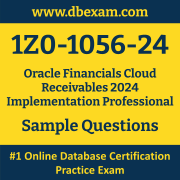01. Which two are rules applicable to issue of refunds?
(Choose two.)
a) You cannot refund more than either the original receipt amount or the remaining unapplied amount.
b) You can refund receipts that were either remitted or cleared.
c) You can issue a credit card refund to a customer who has made a cash payment.
d) You can refund receipts that are factored.
02. Identify the receivables system option that relates to customers.
(Choose two.)
a) Reciprocal Customer
b) Receipt Method
c) Default Country
d) Automatic Site Numbering
03. Your customer wants to retrieve values for the Line of Business segment based on Customer Class for the Revenue account.
Which option would you use to achieve this with the help of the Subledger Accounting solution?
a) Supporting References
b) Mapping Set
c) Transaction References
d) Description Rule
04. In what three ways will changing customer information impact the collection process?
(Choose three.)
a) Changing information on the Profile tab does not have an impact on the level at which collections are done.
b) Adding or modifying customer contact name on the Contacts tab impacts where the correspondence is sent.
c) Making changes on the Profile tab impacts the collection process.
d) Business-unit-level changes will not impact the display of delinquent customers on the dashboard.
e) Changing the Collector impacts the individual working with the delinquent customer.
05. A Billing Specialist creates an adjustment for an incorrect invoice that exceeds a user’s approval limit. What is the status of the adjustment?
a) Pending Approval
b) Forwarded for Approval
c) Pending Research
d) Approval Required
06. How can a Collector assigned to a Customer modify a strategy that is assigned from the Collections Dashboard?
a) A strategy is automatically assigned based on Scoring and cannot be manually assigned to a Customer by a Collector.
b) Only a Collections Administrator can modify the strategy.
c) The Collector can modify the strategy from the Profile > Strategies tab.
d) The strategy can be modified from the Manage Customers page.
07. Your client's legacy system uses a hierarchical parent/child relationship to organize customer information because a single customer may have more than one bank account or payment method.
Can you use the Oracle Fusion Trading Community Model Data Import program to represent this hierarchy?
a) The program allows the use of parent, child, and grandchild table hierarchies, but it requires multiple Customer Master records for each customer within the hierarchy.
b) The program allows table hierarchies for customer bank accounts, but not for other customer information.
c) No; the program contains parent, child, and grandchild table hierarchies to represent the hierarchy of data in the customer information.
d) Yes; the program supports parent, child, and grandchild table hierarchies to represent the hierarchy of data in the customer information.
e) The use of parent, child, and grandchild table hierarchies is allowed only in Accounts Payable, not Accounts Receivable.
08. What information does the Collector see in the Activities List area of the Collections Dashboard?
a) summary of aged transactions
b) tasks assigned to the Collector, such as follow-up calls
c) status of processing activities from the Process Monitor
d) customer search as per the parameter specified
e) customer’s profile for each assigned customer
09. Your customer has three sites defined in the system, site 1, site 2, and site 3. All sites have their own billing strategy defined and Balance Forward Billing is enabled for site 1 and Site 2 at the account level.
How will bills be generated?
a) Sites 1, 2, and 3 activities will be included in a single bill.
b) Sites 2 and 3 activities will be included in a single bill.
c) Sites 1 and 2 activities will be included in a single bill.
d) Sites 1 and 3 activities will be included in a single bill.
10. Where is the summary delinquency data displayed on the Collections Dashboard?
a) Activity tab
b) Correspondence tab
c) Aging tab
d) Profile tab
 The Oracle Financials Cloud Receivables Implementation Professional (1Z0-1056-24) Sample Question Set is designed to help you prepare for the Oracle Financials Cloud Receivables 2024 Certified Implementation Professional certification exam. To become familiar with the actual Oracle Certification exam environment, we suggest you try our Sample Oracle 1Z0-1056-24 Certification Practice Exam.
The Oracle Financials Cloud Receivables Implementation Professional (1Z0-1056-24) Sample Question Set is designed to help you prepare for the Oracle Financials Cloud Receivables 2024 Certified Implementation Professional certification exam. To become familiar with the actual Oracle Certification exam environment, we suggest you try our Sample Oracle 1Z0-1056-24 Certification Practice Exam.